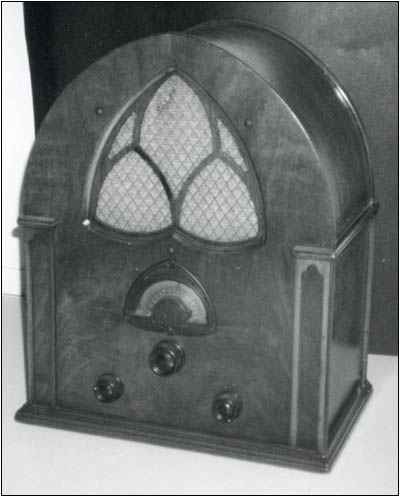Of Old Radios And Related Items--Published Monthly
Atwater Kent Model 84
BY RICHARD ARNOLD
Web Edition
"It pays to advertise" is the message sent by Richard Arnold's article telling how he acquired a nice Atwater Kent Model 84. (Editor)
I purchased this Atwater Kent Model 84, shown in Figure 1, sometime in the fall of 1985 when I was a brand new collector. At the time, I was selling insurance and used to include radio cards in monthly statements. I had one customer who brought a radio to my office where we agreed upon a price of $75. This was my first cathedral, the Atwater Kent Model 84. Needless to say, I was so impressed by the beauty and size of this radio that from that time on I was hooked not only on collecting radios, but also on cathedrals in particular.
The Atwater Kent Model 84
Mr. Charles S. Bradley first designed the Atwater Kent 84 in 1931. The design patent was applied for on February 17, 1931, and the patent #84316 was issued on June 9, 1931.
Since it measures 19" x 15 7/8" x 9 7/8" with its Gothic arch, the Atwater Kent 84 is considered a compact style. In the fall of 1931, an Atwater Kent radio ad states the following: "Model 84, golden voiced compact with the pentode tube. The cabinet has a Gothic front of matched butt walnut. The sides are of selected striped walnut. A quick-vision dial. New electro-dynamic speaker. Antenna adjuster, securing full efficiency on an antenna of any length. It has an armored chassis, fully shielded to prevent radiation and has a full rich tone." The radio sold for $69.50. That seems like nothing now, but back in the Depression era that was a large sum of money. Actually, the radio was more expensive than most of its competition.
There were four versions of the Model 84 made. All models had both an early and late version. The model numbers are the following: 84 (part numbers 17500 and 19000; 84F (part numbers 17600 and 19200); 84D (part numbers 17800 and 19300); and 84Q (part numbers 18300 and 19400). The 84Q is the battery version of the model.

Figure 1. The Atwater Kent Model 84.
The radio pictured in this article is the early version of the Model 84. This set is a 6-tube superheterodyne, listed as part number 17500. The six tubes used are as follows: three Type 24 used as 1st IF, 1st and 2nd detector; one Type 47 1st AF; one Type 27 oscillator; and one Type 80 rectifier. The radio has no tone control, but the later version of the Model 84, part number 19000, does have tone control, as do all other late versions. It also has a slightly different cabinet style and tube type lineup consisting of two 35s, one 24, one 47, one 27 and one 80.
The tube lineups for the other three models are as follows:
Model 84F (early): three Type 24s, one 27, one 47 and one 80.
Model 84F (late): one 24, one 27, two 35s, one 47 and one 80.
Model 84D (early): one 33, three 36s, and two 37s.
Model 84D (late): one 33, three 36s, and two 37s.
Model 84Q (early): two 30s, four 32s and one 33.
Model 84Q (late): two 30s, four 32s, and one 33.
The 84F is a 110v 25-cycle; the 84D is a 110v DC; and, as stated earlier, the 84Q is a battery set.
This Model 84 tunes only the broadcast band. The three Bakelite knobs are for controlling the tuning, on/off and volume. The radio uses a 180-degree, or half-moon, lighted, dial scale, with a metal escutcheon. The grille cloth is the original diamond pattern.
Of all the Atwater Kent cathedrals, this Model 84 is considered the most common. It has a plain looking cabinet when compared to the other Atwater Kent cathedral cabinet styles. However, it is still a very desirable radio and commands a high price.
Over the years I have continued to collect cathedrals. Even though I have many other styles of radios in my collection, the cathedrals still hold a special place.
Reference:
Atwater Kent Service Data, November 1931
Richard Arnold, P.O. Box 275 Lone Grove, OK. 73443. E-mail: arnold@brightok.net
Richard Arnold, a frequent contributor to A.R.C., has been collecting radios since 1985. His interest is primarily in cathedrals and 1920s battery sets, and his collection ranges from crystal sets to a 1928 American Bosch in a Pooley cabinet. His prize is the 1932 Jackson Bell Peter Pan featured in the June 1991 A.R.C.
| [Free Sample] [Books, etc., For Sale] [Subscribe to A.R.C./Renew] [Classified Ads] [Auction Prices] [Event Calendar] [Links] [Home] [Issue Archives] [Book Reviews] [Subscription Information] [A.R.C. FAQ] URL = http://www.antiqueradio.com/Apr04_Arnold_Model84.html Copyright © 1996-2004 by John V. Terrey - For personal use only. Last revised: April 2, 2004. For Customer Assistance please contact ARC@antiqueradio.com or call (866) 371-0512
Antique Radio Classified |